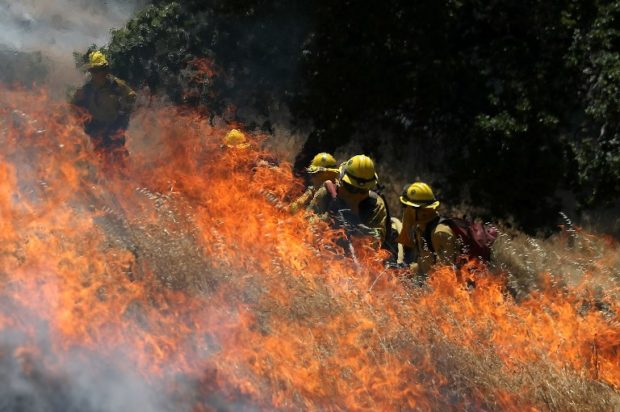
Marin County Fire Department seasonal-hire firefighters use a hose during a controlled burn training on June 16, 2017, in San Rafael, California. Seasonal-hire firefighters with Marin County fire department participated in a live fire wildfire training ahead of what is expected to be a busy year for wildfires in California. On Saturday, July 8, 2017, major wildfires raged across California as it was gripped by a record-breaking heatwave. AFP
LOS ANGELES, United States — The first major wildfires after the end of California’s five-year drought raged across the state Saturday as it was gripped by a record-breaking heatwave.
Around 2,300 firefighters were battling several blazes with triple-digit temperatures recorded in valleys and inland areas.
A wildfire in the Sierra Nevada foothills north of Sacramento was only two percent contained and had destroyed 10 homes by midday, scorching 2,000 acres (800 hectares) of forest and sparking small-scale evacuations.
The California Department of Forestry and Fire Protection (CalFire) said five residents and a firefighter had sustained minor injuries.
Meanwhile a blaze that forced evacuations in Santa Barbara County doubled in size overnight to 5,750 acres, fanned by hot, dry winds.
Some 17 wildfires in various states of containment were burning in California Saturday, from the Six Rivers National Forest in the north to the San Bernardino Forest, west of Los Angeles.
An excessive heat warning has been extended until 11:00 pm (0600 GMT) for much of southern California, with temperature records being broken across the region.
Downtown Los Angeles tied the 1954 record of 96 degrees Fahrenheit (36 Celsius) while the city’s northwestern suburb of Woodland Hills reached a high of 109 degrees, breaking the record of 108 set for the date in 2006.
“Dangerous and potentially life-threatening heat is expected through (today), when high temperatures between 100 and 110 degrees are expected for many interior sections of southwest California,” the National Weather Service (NWS) said in a statement.
The weather service attributed the heat wave to a “strong upper-level high-pressure system centered over the desert southwest,” adding that the heatwave could continue into Sunday.
“Hot temperatures will create a dangerous situation in which there is an increased threat of heat-related illnesses. The extended heat wave will also bring elevated fire weather conditions through the weekend,” said the NWS.
California Governor Jerry Brown in April declared the official end of the state’s drought that lasted more than five years.
But he kept in place water reporting requirements, as well as bans on practices like watering during or following rainfall and hosing off sidewalks.
“This drought emergency is over, but the next drought could be around the corner,” Brown said in a statement. “Conservation must remain a way of life.” CBB